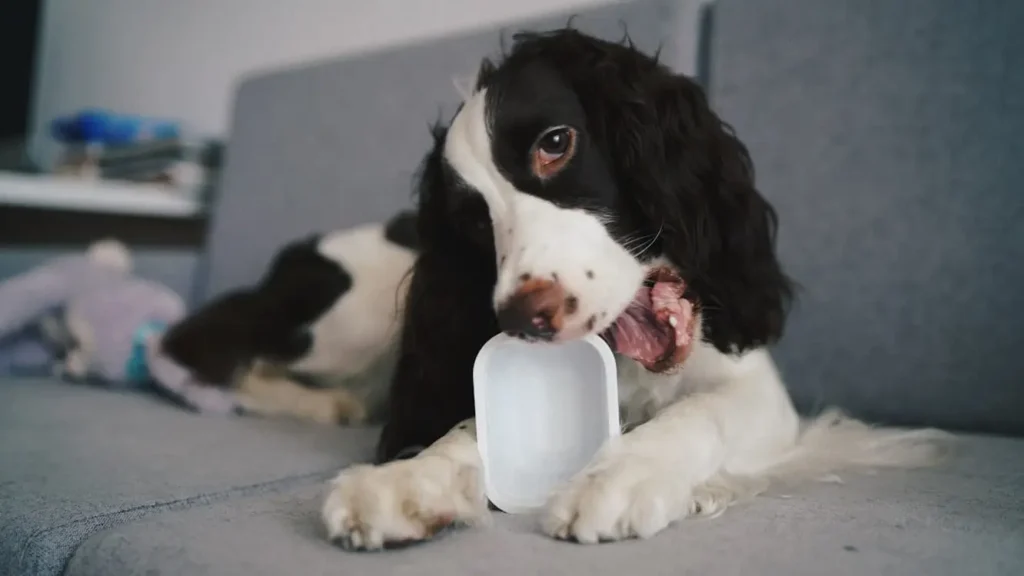Wondering can dogs eat vanilla yogurt? As a devoted pet parent, you might be tempted to share this creamy, tangy treat with your dog, especially with its reputation as a probiotic powerhouse. But is vanilla yogurt safe for dogs, and how does it stack up against plain yogurt? In this guide, we’ll explore every angle—is vanilla yogurt good for dogs, the science behind its benefits, potential risks, precise feeding guidelines, and expert-backed alternatives. Drawing from top-ranking veterinary sources, peer-reviewed studies, and pet nutrition expertise, we’ll address content gaps like breed-specific needs, lactose intolerance management, homemade recipes, and even how yogurt interacts with canine medications.
Is Vanilla Yogurt Safe for Dogs? A Detailed Breakdown
Yes, dogs can eat vanilla yogurt in small, controlled amounts, but it comes with caveats. Unlike plain yogurt, which veterinarians often recommend for its simplicity and low risk, vanilla yogurt introduces variables like added sugars, artificial flavors, and potentially toxic sweeteners like xylitol. Here’s the science:
- Plain vs. Vanilla Yogurt: Plain yogurt, especially Greek or nonfat, is the gold standard because it’s low in lactose (which 70-80% of adult dogs struggle to digest) and free from additives. Vanilla yogurt, even when labeled “natural,” often contains sugars or flavorings that can upset a dog’s stomach or contribute to long-term health issues like obesity.
- Key Safety Check: Always read labels. Avoid yogurts with xylitol (a sweetener lethal to dogs, causing rapid hypoglycemia or liver failure) or high fructose corn syrup. Opt for brands using natural vanilla extract (non-alcoholic) and minimal sugar.
- Lactose Intolerance: Most adult dogs lose lactase enzyme production post-weaning, making dairy digestion tricky. Symptoms like diarrhea or gas are common if overfed. Greek yogurt is better due to its lower lactose content (about 4 g per cup vs. 12 g in regular yogurt).
Comparison Table: Plain Yogurt vs. Vanilla Yogurt for Dogs
| Feature | Plain Yogurt | Vanilla Yogurt |
|---|---|---|
| Lactose Content | Low (Greek: ~4 g/cup) | Moderate (~10–12 g/cup) |
| Additives | None | Sugars, flavors, possible xylitol |
| Probiotic Content | High (live cultures) | Variable (heat-treated may lack cultures) |
| Safety | High (vet-approved) | Moderate (check ingredients) |
| Best Use | Daily supplement | Occasional treat |
| Example Brands | Chobani Plain Greek, Fage 0% | Siggi’s Vanilla (check for no xylitol) |
Pro Tip: If choosing vanilla, select organic or artisanal brands with minimal ingredients. Better yet, make your own (recipe below) to control quality.
Deep Dive: Health Benefits of Vanilla Yogurt for Dogs

When chosen carefully, vanilla yogurt offers dogs a range of nutritional benefits, primarily driven by its probiotic and nutrient profile.
1. Probiotics for Gut and Immune Health
Yogurt’s live cultures (e.g., Lactobacillus and Bifidobacterium) act as probiotics, fostering beneficial gut bacteria. A 2023 study in Veterinary Sciences found that probiotics improve digestion, reduce inflammatory bowel disease symptoms, and enhance immune response in dogs. Benefits include:
- Diarrhea Relief: Probiotics stabilize gut flora, helping with antibiotic-induced or stress-related diarrhea.
- Allergy Reduction: A balanced gut can reduce skin and food allergies, common in breeds like Bulldogs or Retrievers.
- Mood and Behavior: Emerging research links gut health to lower anxiety, as the gut-brain axis influences serotonin production.
2. Nutrient Profile: Beyond Probiotics
Vanilla yogurt (if low-sugar) provides:
- Calcium (200–300 mg/cup): Supports bone density, critical for growing puppies or large breeds prone to hip dysplasia (e.g., German Shepherds).
- Protein (10–20 g/cup): Aids muscle maintenance, ideal for active dogs like Border Collies or seniors with muscle loss.
- B Vitamins (B-12, Riboflavin): Boost energy metabolism and nerve health.
- Phosphorus and Magnesium: Support joint and heart health, often overlooked in basic guides.
3. Dental and Weight Management
Yogurt’s creamy texture can scrape plaque, improving oral health, while its protein content promotes satiety, aiding weight control in overweight dogs. Frozen yogurt treats also engage dogs mentally, reducing boredom chewing.
Breed and Age-Specific Benefits
- Puppies: Higher lactase levels make yogurt a safe weaning aid, boosting gut flora for immunity.
- Small Breeds (e.g., Yorkies, Chihuahuas): Calcium supports fragile bones; probiotics help sensitive stomachs.
- Large Breeds (e.g., Labs, Great Danes): Probiotics reduce joint inflammation linked to gut health; calcium aids bone strength.
- Senior Dogs: Probiotics combat age-related digestive slowdown; protein supports muscle retention.
Risks of Vanilla Yogurt for Dogs: What to Watch For
Despite its benefits, vanilla yogurt poses risks, especially if improperly selected or overfed.
1. Lactose Intolerance and Digestive Issues
Up to 80% of adult dogs are lactose-intolerant, lacking sufficient lactase to break down milk sugars. Symptoms include:
- Bloating, gas, or diarrhea (often within 4–12 hours).
- Vomiting or lethargy in severe cases.
Greek yogurt is better, with 50–60% less lactose, but even then, start with 1/4 tsp to test tolerance.
2. Sugar and Artificial Sweetener Dangers
Vanilla yogurts often contain 15–25 g of sugar per cup, risking:
- Obesity: Adds empty calories, a concern for sedentary breeds like Pugs.
- Dental Issues: Sugars feed plaque-causing bacteria.
- Diabetes: Spikes blood sugar, dangerous for diabetic dogs.
- Xylitol Toxicity: This sweetener, found in some “sugar-free” yogurts, causes insulin spikes, seizures, or liver failure.
3. High Fat and Pancreatitis
Full-fat yogurt (over 3% fat) can trigger pancreatitis, especially in breeds like Schnauzers or dogs with prior episodes. Symptoms include vomiting, abdominal pain, and lethargy. Stick to nonfat or low-fat (0–2%).
4. Allergies and Sensitivities
Dairy allergies affect 1–3% of dogs, causing itching, ear infections, or skin rashes. Vanilla’s additives (e.g., artificial flavorings) may worsen reactions in sensitive breeds like Westies or Boxers.
5. Medication Interactions
Probiotics in yogurt can interfere with antibiotics or immunosuppressive drugs, reducing efficacy or causing gut imbalances. Consult your vet if your dog is on meds like metronidazole or cyclosporine.
Risk by Breed and Condition
- Brachycephalic Breeds (e.g., Bulldogs): More prone to digestive issues; limit to tiny portions.
- Diabetic Dogs: Avoid vanilla due to sugar spikes; plain only under vet guidance.
- Pancreatitis-Prone Breeds: Skip high-fat yogurt entirely.
How to Feed Vanilla Yogurt to Dogs: Precise Guidelines
To maximize benefits and minimize risks, follow these evidence-based feeding tips. Yogurt should comprise less than 10% of daily caloric intake to avoid nutritional imbalances.
Recommended Portions by Dog Size
| Dog Size | Weight | Serving Size | Frequency |
|---|---|---|---|
| Small | <20 lbs | 1/2–1 tsp | 1–2×/week |
| Medium | 20–50 lbs | 1–2 tsp | 2–3×/week |
| Large | >50 lbs | 1–2 tbsp | 3×/week |
- Puppies: 1/4 tsp, 1×/week (higher lactase tolerance).
- Seniors: 1/2 adult portion, as digestion slows with age.
Feeding Methods
- Mix with Food: Blend into kibble to enhance palatability and digestion.
- Frozen Treats: Spoon into Kong toys or ice cube trays for mental stimulation.
- Lick Mats: Spread thinly for anxious dogs to soothe through licking.
Introducing Yogurt Safely
- Start with a 1/4 tsp test dose to monitor for digestive upset or allergies (watch 24–48 hours).
- Increase gradually over 1–2 weeks if no adverse reactions.
- Always pair with a balanced diet; yogurt isn’t a meal replacement.
Homemade Vanilla Yogurt Recipe for Dogs
Commercial vanilla yogurts often carry risks, so making your own ensures safety and customization. This vet-approved recipe is simple and dog-friendly.
Ingredients
- 1 cup plain Greek yogurt (nonfat, live cultures)
- 1/4 tsp pure vanilla extract (alcohol-free; check label)
- 1/2 mashed banana or 1 tbsp pumpkin puree (for natural sweetness)
- Optional: 1 tsp honey (for dogs over 1 year, in trace amounts)
Instructions
- Mix yogurt and vanilla extract in a bowl until smooth.
- Fold in banana or pumpkin for flavor and nutrients.
- Portion into silicone molds or ice cube trays (1 tsp per cube).
- Freeze for 2–3 hours. Store in airtight container for up to 10 days.
Yield: 8–10 small treats. Serving: 1 cube per 10 lbs body weight, 1–2×/week.
Why It Works: Controls ingredients, eliminates xylitol/sugar risks, and adds fiber from fruit.
Alternatives to Vanilla Yogurt for Dogs
If vanilla yogurt’s risks outweigh benefits for your dog, consider these safer, vet-recommended options:
- Probiotic Supplements – FortiFlora or Proviable provide targeted probiotics without dairy’s lactose.
- Dairy-Free Yogurts – Coconut or almond milk yogurt (xylitol-free) for dogs with dairy allergies.
- Fruit-Infused Plain Yogurt – Blend plain Greek yogurt with dog-safe fruits like blueberries, apples, or carrots.
- DIY “Puppuccino” – Mix plain yogurt, water, and a dash of pumpkin for a Starbucks-style treat.
Troubleshooting: What to Do If Your Dog Reacts Poorly
If your dog eats vanilla yogurt and shows issues:
- Mild Symptoms (gas, mild diarrhea): Withhold food for 12–24 hours, offer water, and resume bland diet (rice, boiled chicken).
- Severe Symptoms (vomiting, lethargy, blood in stool): Contact your vet immediately; suspect xylitol or pancreatitis.
- Allergic Reaction (itching, swelling): Give vet-prescribed antihistamines if known; seek emergency care for breathing issues.
FAQ
Is vanilla extract safe for dogs?
Pure, alcohol-free extract is safe in trace amounts.
Can vanilla yogurt help dog yeast infections?
Probiotics may reduce gut-related yeast overgrowth, but yogurt isn’t a cure.
What if my dog ate a whole cup of vanilla yogurt?
Monitor for digestive upset or xylitol poisoning; call your vet if symptoms occur.
Does yogurt help with dog anxiety?
Probiotics support gut health, which influences serotonin and may reduce stress.
Conclusion: Treat Wisely for a Healthy Pup
Can dogs eat vanilla yogurt? Yes, but only in moderation, with careful selection to avoid sugars, xylitol, and high fat. Plain Greek yogurt remains the safer, vet-preferred choice for its low lactose and high probiotic content. By addressing breed needs, offering homemade recipes, and exploring alternatives, this guide ensures you can treat your dog without compromising health.

